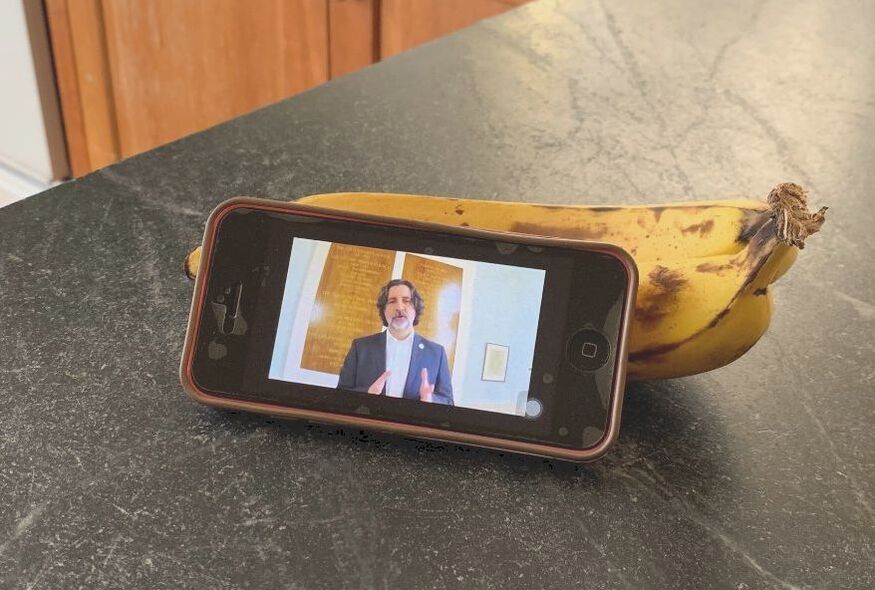 What church looked like for so many people during the plague. What church looked like for so many people during the plague. In my previous post I wrote a bit about the "whys" of the process of making youtube videos. You should probably check that out for more information. That said, the reasons are pretty basic. One is that they provide a creative outlet for me. They are a way to generate a dialogue with nature and with others who might be interested in the experience. Also, this experience is a bit of an experiment into the possibilities for spiritual communities, who will increasingly find themselves in need of creative ways to reach out beyond their doors. In addition to the previous post, you might be interested in the reasoning behind the initial project or my attempt at a method for sabbath walking, which underlies a lot of this work. However, what I would like to do in this post is share some videos, talk about my motivation to make them, and discuss a little about what I have learned from them. I will be going in reverse chronology--most recent to least recent--as it may help to set where I am now before talking about where I have been. Mount Watatic in Winter: This video is fairly typical of what I have been trying to do. The format is fairly well established at this point. It opens with a description of why I am hiking the trail and what I--or we--hope to see. I also talk about my relationship with the walk. In this case I am climbing my favorite mountain. Earlier hikes up Mount Watatic helped me to refine my thoughts on mindful walking. Technically there are still problems. While the music has improved a bit, I am still not a great musician. There are compression issues and sound issues, too. These are all problems that could be fixed with money...which I do not have. I am using my phone for all the elements of recording. I am using a fairly basic editing platform (Filmora) which is probably best suited for end-of-year high school slideshows. The musician is free. Also, I was not terribly satisfied with much of the footage I recorded initially. It took quite a bit of work to tell this story. Mount Kearsarge (South) in Winter: This video was fun to make because I had the company of my wife Allison! She did some recording of me and I could also record her. The addition of people--including an anonymous fellow traveler--gives the video more motion to carry the story. Also, while Watatic is important to me, one could argue that Kearsarge has more general importance. There were a lot of human (historical and artistic) resources for this video, which helped. The view from Kearsarge is also one of the best in New England. By the time I got to this video I felt I had hit a wall technically. The music needed to be updated. You will hear some of these same cuts in every video as we go back in time. Why bother with music? It helps to move the story along. There are walks-and-talks that need a little something sometimes. There are moments when the view is the story and some framing is necessary. That said, it went together fairly quickly, which was nice. Tecumseh in Winter This was a fun one. I recorded it just a couple days before the Kearsarge hike so many of the points in that video are relevant here. I had a friend with me--Andy Linscott--and we knocked out one of our favorite 4,000 footers. Here we had the challenge of too many people, which made recording awkward at times. For some reason editing was a BEAST. You will note a couple spots where the sound gets clipped a bit. I will say that after this video I tried to develop a method for layering the various elements together; completing one layer before starting the next. The system is imperfect but having one was probably the adjustment that made the Kearsarge and Watatic edits go more smoothly. Finally, this marks--I think--the ideal length for one of these videos. Keeping it Between 8 and 9 minutes tells the story before tedium sets in. I feel this way about sermons, too. However, it seems easier to stay tight when you have another hiker with you. My solo climbs are all a bit longer. Poet's Seat, Deerfield, MA I had the most fun making this video. It is different from the others in that the hike, itself is relatively unremarkable. Instead I spent time talking about the poet Frederick Tuckerman. He is relevant to the walk. Things don't always work out that way so I took advantage of the opportunity You will note there is no music in this. My one assignment from my son was to record voice overs instead of leaving long stretches of relatively silent (or scored) walking. Thankfully Tuckerman had enough poems to fill things in. Also, this was the first time I used a tripod mount for my phone. This enabled me to film myself sitting and walking. It feels ridiculous while you are doing it. However, it does help to give motion to the narrative. This is a worthwhile practice...if you can avoid other people. Starting Seeds and Hiking High Ledges Before these videos--and you are welcome to look--my channel was mostly either panoramic views of mountains I climbed, sermons I wanted to share, or music from our various music ministries. I think one can also find some of the earliest pandemic worship services hosted here before we got the church youtube page updated. That was fun too. The services were even necessary. I do feel, though, that the two videos below mark the beginning of something new. Like the pandemic worship videos, they are self-contained and internally consistent. The goal is not to record something and say "look what is going on out there." Instead they say "look what is happening right here." That is an important distinction between, say, an edited youtube worship video and a recording of a live-streamed worship video. The first has an immediacy. The second is a document of something that happened in the past. With these nature vids I am looking for immediacy. They differ from the pandemic material in that while they may be spiritual or even worshipful in some ways, they are not beholden to the traditional ideas behind those concepts. They are meant to have their own patterns and pacing because both the media and the context are different. I am putting these two together because they show some of the same challenges. They are both too long, The planting video in particular drags in the middle and is saved by my cat. There are too many musical interludes in the hiking video and there is a sort of "reflection" bit that goes on too long at the end of both of them. I think that somewhere in my subconscious was the form of a traditional worship service. I wanted a "sermon" of some kind. Still, I like them. They are watchable and they represent an effort to do something creative and new.
The struggle in all this video-making is the same struggle any artistic act has. I try--as in preaching--to ask myself how I am inviting others to inhabit this world I am presenting. After all, true inhabitation of life is part of the goal of a good sabbath. Putting yourself out as a religious or spiritual professional means building those bridges so that people may cross to that "place" (an emotion, idea, action, or actual place, for example) that we would like them to journey to and dialogue with.
The goal is not to impress others with your accomplishments or enlightenment, but to reach out to where they are and welcome them on the journey. It isn't what I see but what you see that is important. I am just pointing out good places or moments to begin. This change in media has helped with this process of mindful composition. I hope to do more when I can. That said, I am back at work. Palm Sunday and Holy Week are on the horizon. These are steeped in tradition. It may be a while before the next great explore...
0 Comments
I am having a bit of a crisis with one of my plants. It is a large ginger that sits near the television and is truly quite a looker. This fall I added some houseplants as a way to get some green living things in my life before the snow and the cold made everything bleak. I got them free from a landscaper friend and the others are all in various levels of health. The ferns seem happy. The bamboo...I don't even know how to read but I think it needs water. My two old plants--an ancient Ficus older than my marriage and a Spider Plant--look like the grizzled survivors they are. It is this ginger plant that is bothering me right now though. A few days ago yellow leaves started to appear. I did some reading and I learned that it could be too much water...or not enough water...or too much sun...or not enough sun...or an incurable disease. Good times. After a few days of stress I bit the bullet and watered off schedule. The other plants--except maybe that bamboo--don't seem to need much as long as it is regular. Now I wait to see if I drowned it. I think it is time for a garden roundup. The year has ended and so has the growing season. Maybe it is time to take a look at how things went and consider the future. 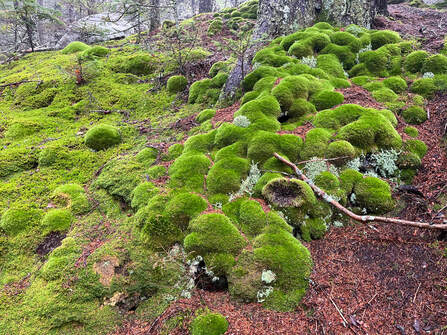 Moss, lichen, and trees making a heroic stand in the shallow soil of Black Mountain (Benton). Moss, lichen, and trees making a heroic stand in the shallow soil of Black Mountain (Benton). This year was a bit of a baseline project. I have pretty much always had a garden in the same way I have always hiked. I do it...but not well. Of course there are differences. Hiking is something with a simple skill set. The living thing you take care of is yourself. The basics--putting one foot in front of the other--are obvious. On a hike you are testing yourself, your physical ability, mental fortitude and skill. Gardening is all of that with added levels of complexity as the ecology of our surroundings have their own ideas. This is the story of the ginger plant. They aren't built to live near a TV in New England. For all intents and purposes the plant--all the houseplants, in fact, and in some sense the outdoors plants as well--is in the same situation as the ones in those tiny alpine ecosystems clinging to the cracks in a rocky ledge. All of them are desperately trying to make a home in a place with limited resources. The alpine plants are actually better situated. They have adapted to live in those environments. The ginger, the ferns, ficus and so on are dependent on the relative competence of a middle-aged practical theologian with no real sense of what they need. So we have to ask ourselves, as people who care for plants, a number of questions. Broadly speaking, How do we make a curated space for growing things? What sort of dialogue between grower, subject plants, neighbor plants, neighbor people, and the local ecosystem--living room, lawn, or garden--can be arranged so as to be fruitful for the season? There are real stakes in this conversation. They are about survival for the vegetation. For me, the stakes are also relatively high. When I was recovering from COVID this past spring my biggest joy was sitting by the garden with my coffee. The same could be said for the time of my back injury. The conversations between these elements is important for all our wellbeing. 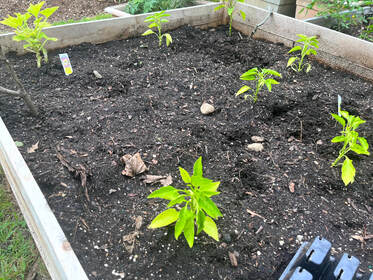 Cubanelles and a yellow squash. The peppers ruled the garden. The squash did not. Cubanelles and a yellow squash. The peppers ruled the garden. The squash did not. So...this past year it felt like I planted a ton of stuff. The plot is small. However we did add another raised bed to the operation. That may be it for now. One thing I learned was that the whole mess of beds and pots is awkwardly situated for the goal of maximized yield. The elbow of the house gets spotty light, which is good for some things but not others. Also, it has been churned up a couple of times to get to various infrastructure items that we unwittingly planted over. Finally, it is in a tight spot on the narrow driveway. The cars are single file so sometimes one's bumper makes contact with the outermost raised bed while backing over the lawn with the front car in line. Still, I don't think I will move it. It just will be the size it is for the time being. The original site selection was simply because most of the parsonage is exposed to the view of passersby. The garden corner is literally the only spot with any privacy, which makes it a nicer place to sit. Also, gardens are ugly--or can be deemed ugly--sometimes and I didn't need neighbors calling the church to complain. Yes...that is a thing. 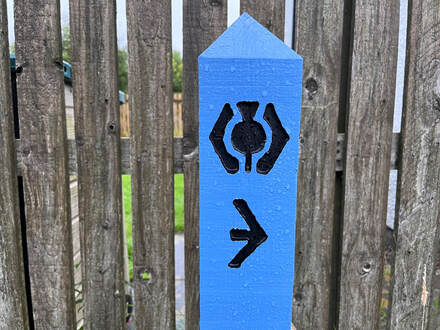 Not a globe thistle but an abstract thistle of some kind and the marker at the beginning of the Great Glen Way. Not a globe thistle but an abstract thistle of some kind and the marker at the beginning of the Great Glen Way. Anyway, I planted things and some did well. The potatoes were a successful early experiment. I planted reds, which were excellent and a variety of "Irish" potatoes that were healthy at first but ended scabby. I will probably plant reds in bags next year. Our pepper situation was ridiculous in a good way. Jedi and Padron--grown from seed--made room for Shishito, Purple Bells, Italian Cherries, and Cubanelles, some of which were planted in the potato bed after those were harvested. They all loved the heat of the Global Warming Summer and kept on giving until the cold set in. Herbs like basil, chives, thyme, Greek Oregano, lavender (new plant to replace a prolific old one) and rosemary (same) anchored the herb bed and made good meals better. Salad greens--mostly arugula--were harvested in their "baby" phase and used to spice up older greens from the farm my sons work at. The flowers--mostly in pots surrounding the beds--were much appreciated by me this year. My favorites were the Globe Thistle--a tribute to our Scotland trip--and the abundant dahlias. It was full 1950's for a while with massive blooms lending their color to the brown drought-stricken landscape. I have actually made an attempt to dry the tubers and use them next year. I fully expect failure but it would be fun...and none of the dahlia varieties I grew this year were rare. 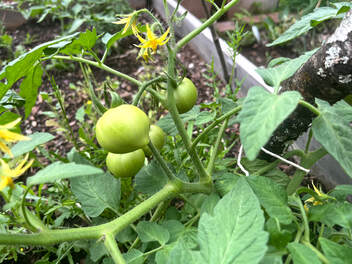 Tomatoes in happier times Tomatoes in happier times Let's not breeze by the failures. Yellow squash and cukes stood no real chance. We had watering issues and blight. They suffered from our trip to Scotland. The tomatoes were prolific...and immediately eaten on the vine by a rabbit and a chipmunk family before we ever got to use most of them. We lost ton of herbs and strawberries to them as well. We had pointless stevia plant. Finally, that rhubarb now 3 years old continues to not thrive. Alas! What can you do? 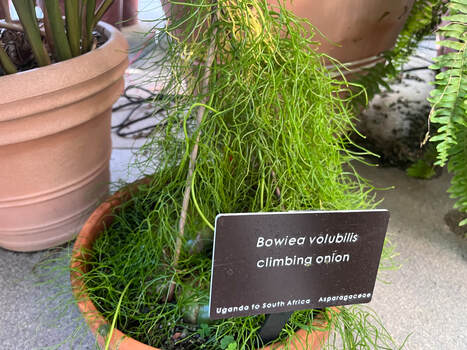 Frances Tophill suggests Climbing Onion as a plant to try. I found this one at Tower Hill. Frances Tophill suggests Climbing Onion as a plant to try. I found this one at Tower Hill. Well....you can plan for next year, right? After Christmas Day we took a field trip over to the greenhouses at the New England Botanic Gardens at Tower Hill. This was inspirational. I took lots of boring pictures of healthy houseplants and novelty vegetables. I am looking forward to going back there an learning more as time allows. Also, as I have mentioned earlier, I have been doing some reading. Celia Thaxter's book--that I mentioned in a previous post--is rarely shelved. My Christmas gift to myself also included some intriguing titles. I am almost through "The Philosophy of Gardening" edited by Blanka Stoltz and originally written in German. This collection of essays is deeply wonky and has given me a good sense of the state of the garden movement in Europe as well as some ideas for when I have more space. I have also cracked into two books by Frances Tophill. One has practical advice that I have already put to use in my quest to save my ginger plant. The other is about planning out a garden for the first time. Again, I don't have the space now, but maybe someday. There are a couple of others as well that I have consulted and will consult again. Now we are reaching 2023 futures planning. In addition to potatoes and peppers again, I hope to plant some weird things that I cannot get at the store or from the aforementioned farm my sons work at. The space I have does not lead to self-sufficiency really, just life-improvement. I am well into the planning stages and am considering seeds. Our neighbors next door--who are apparently fine with gardens--gave us some zucchini. I actually made a salad from them that I liked. Maybe, just maybe, one plant...
There will be flowers, too. Ever since the plague I have valued the aesthetic elements of the garden. It is a somewhat wild spot in the midst of the manicured lawns and the pavement that surround us. I have had a lot of coffee out there and written a ton of sermons. May it continue to be inspirational. We could all use an inspiring year. 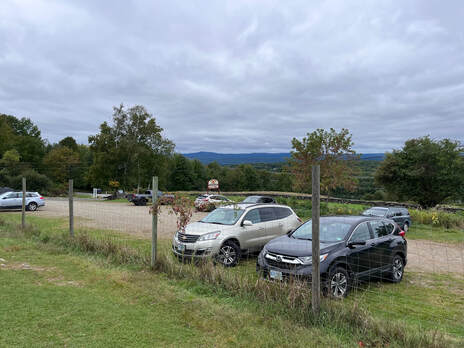 The parking lot at Windy Hill Farms in Haverhill, NH after the school busses left. It is a nice spot if you are up that way. The parking lot at Windy Hill Farms in Haverhill, NH after the school busses left. It is a nice spot if you are up that way. After my climb up Black Mountain, I went apple picking. I had noticed the place on my way to the trailhead and was tempted. Then the woman I talked to at the peak told me her family works there. When I was younger and the children more pliable, Al and I used to take them picking quite frequently. It got us out on a Sunday afternoon and was a low-stress social option for adults and families alike. Also, in the end there would be apples. Who can complain about that? I grew up working for my grandfather on school vacations and during the summer. He had apple trees. That said, the apples--like the extensive garden next to it--were for family use. The big sale items on the farm were Christmas trees, actually. Also, he contracted out to raise heifers for Heifer International. He cut hay for himself and other local farmers. He grew corn and other crops primarily for the heifers. Once he boarded someone else's sheep for a while. The apple trees were the personal passion of a guy with plenty of passions. They would be pruned and the pests abated in the off-season. Then we would harvest them throughout the fall and put them in barrels on the porch, pulling them out when we felt like it. I remember sitting on that porch the day before Thanksgiving munching apples while waiting for my cousins to arrive. I did this more than once. At home we had apples, too. There was a big, old apple tree whose variety is best described as "green and wormy" along with a couple crabapple trees. My mom--not to be outdone by her father--built a cider press in our yard. We would spend days grinding apples and squeezing them, producing gallons and gallons of unfiltered, unpasteurized apple-and-bug juice that we would start drinking immediately. Jugs of the stuff would go down in the basement for safekeeping. Then it would slowly ferment through the winter. We usually ran out in early March. 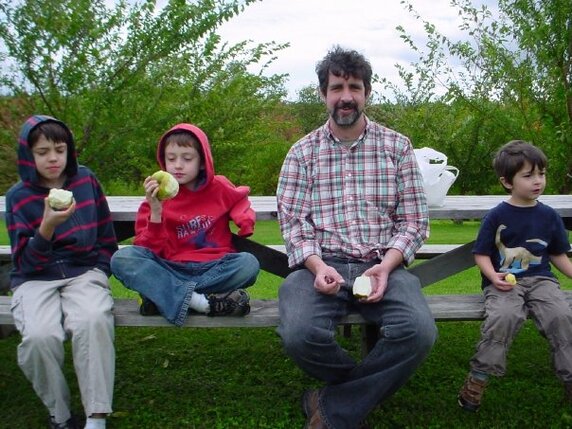 A younger me alarmed at the price of apple-picking at Nicewicz Farm in Bolton, MA. This is our "go to" place. It is unpretentious and the apples are excellent. It is also a great place for pumpkins! A younger me alarmed at the price of apple-picking at Nicewicz Farm in Bolton, MA. This is our "go to" place. It is unpretentious and the apples are excellent. It is also a great place for pumpkins! As an adult, of course, the whole process has been a bit more commercialized. It is safe to say that the cost per bushel and peck is substantially over the free-with-labor rate of my youth. It took me a while to get used to that. There is something strange about paying to work instead of the other way around. I have learned, of course, that this is how the local orchards survive; preserving an endangered economy along with varieties that would be hard to find otherwise. That there are more than Macintosh, Granny Smith, Red Delicious, and Cortland apples in the grocery store is a direct result of these orchards maintaining their many trees in all their variety. This is part of the fun, of course. One place we used to go to when we were younger parents had a tree that was older than the memory of the family that ran it. Every other year those apples are the best ever. On the off year they taste like rotting grass. Nothing compares to an apple so I don't know how to describe the flavor. They taste like fall, family, and farm work to me. I am going to pretentiously say they taste like America, or, rather, its best parts. That said, there are sweeter ones and less sweet. Some outliers have their own thing going on that can be pleasant or really not pleasant depending on the environment they are raised in. The taste also depends on the mood of the eater. Even the varieties themselves vary by tree. Let's talk variety for a minute. When I was growing up it was either the green wormy variety or Macs at home. Mom still insists on Macs to this day. My grandfather's fruit were varieties of Golden Delicious although some of the trees were more delicious than others. Maybe because of how may of these particular apples I ate when I was a kid, I tend not to get them now. Also, I am not fond of off-season varieties. They are mealy and taste a bit manufactured. 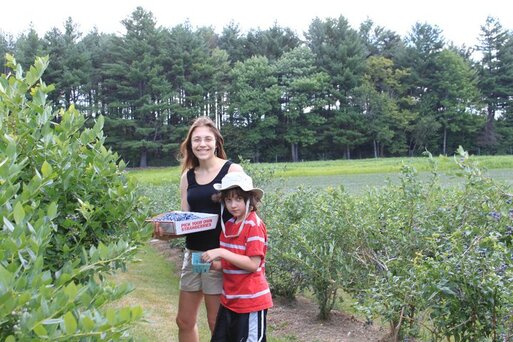 Yeah those are blueberries, but we used to pay to pick those, too. Yeah those are blueberries, but we used to pay to pick those, too. It turns out only two members of my immediate family can be counted on to consume apples in any quantity. One is me. The other one is still living in a tent somewhere in the Appalachian Range. This means the demand these days is low. Usually, therefore, I forego the whole event of picking and just buy a half-peck of local apples that are in season. In fact, that was my plan when I arrived at this particular apple place. There was a school bus full of small children. There were family groups with their seniors. It appeared I was the only one flying solo and the smallest bag for picking is the $14 peck. What a frivolous pursuit for a serious middle aged man! At least that was my initial impression and fear. Then someone in front of me--probably a decade or so younger with a couple bags if donuts--bought an empty peck bag for himself, too. That was all the peer pressure I needed. In the end I had a good time. It wasn't the full-on picking experience of some of those places closer to home. There thankfully wasn't a petting zoo or a pony ride. They sold cider donuts in theory...but that guy in front of me bought the last. There were also a few corny hand painted signs but they kept themselves to defining the boundaries of various varieties and warning people not to bring their dogs. The environment was pretty no-nonsense for an operation like this, which was just what I was looking for. I took my bag and spent about 20 minutes filling it with Macouns and Paula Reds while munching on a Cortland held in my other hand. One of the painted signs said I could eat on the job; "Sample, Don't Feast!" After the Cortland I had a Paula Red. It is early in the season in New Hampshire--and the bigger apples go in bags for the orchard store anyway--so the apples in the field are small and tart. You can't find them at the supermarket like this, where the ideal of the big, puffy, red or green, unblemished apple reigns supreme. Maybe I will make a pie, but really these should be eaten straight up, on the porch. It wasn't like when I was a kid. I didn't prune these trees, or mow between them, or fight the battle of the bugs. I did not feel like a farmer. However, I got my hands a bit dirty to get the freshest new apples I could and that is enough for now. Sometimes it is good to concentrate on one thing. If we focus hard enough we can block out the noise and worry that burdens our movements most of the time. Of course we return the noise. We can't help ourselves because it is in the air wherever we go. However, the rest we find while homing in on a pleasurable task can be just what we need to sustain us in our return. That may actually be the crux of the project I am on. Hiking, music, writing and preaching all require concentration at a level that draws the detritus away. Each word, each note, and each step is a puzzle that requires attention. Gardening can be like that, too. Which is good, because I am not as successful at reaping the more obvious rewards. It has been a while since I updated you on the small parsonage garden. I have been working on it regularly. Sometimes the work takes a couple hours. More often it is just a few minutes. Up until the heat wave, I have been drinking my morning coffee and answering emails by the raised beds while it is still cool. These days I have to get my miles in while I can, so garden visiting has to wait until the hot midday. The fact is, though, I am learning something new each day. Some of those lessons, though, are harder than others... 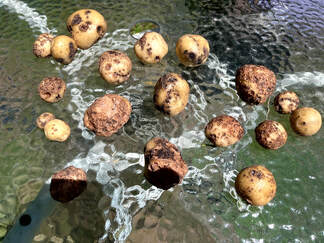 Ewwwww... Ewwwww... Potatoes: Lets start with a mixed bag, shall we? I planted two types of potatoes. This was more than I needed but I was curious about them. Some of my ancestors were Irish and potatoes loom large in their history. I myself grew up in the potato growing state of Maine and lived there as an adult. Potatoes have a special status in a Mainer's heart. After all, we eat way more spuds than lobster. One variety--Irish Cobbler--was a disaster. They had scab and a little rot. The yield was also low. Strangely their neighbors--all Northland Red--were excellent! I don't know why one type succeeded and the other failed but for the first time in my illustrious gardening career...I took a note of it and will get reds in the future. If I feel the need for whites next year I will try Kennebecs...because Maine. 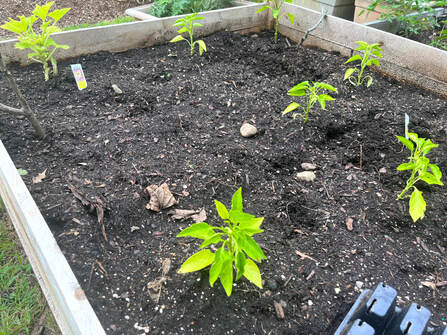 My new Cubanelles...with one yellow squash in the upper right. My new Cubanelles...with one yellow squash in the upper right. Cucumbers: I did not take a picture of the cucumber plant. It is a bushing variety that I got in order to save space and labor. A couple of weeks ago they started to look really bad...or at least some of them did. My first move was to water them religiously. However, they didn't get any better. A consult with my sister-in-law Hanne (who is a professional vegetable farmer, among other things) revealed that they had something called "bacterial wilt." I ended up pulling four plants, leaving me two relatively healthy ones. Peppers: I now have a ton of pepper plants and very few peppers to show for them. I started with a variety including Jedi, shishito, and those round hot ones we used to get at Italian restaurants. Now that the potatoes are gone, I have added cubanelles and one bell pepper. In the heat of summer, maybe peppers will require less work. Tomatoes: At least these are going OK. I got a hardy bushing variety. I have no idea how they taste but they live! I spent a little time with these early on, removing early flowers so that strength could go to the plant. Now there are many, many unripe tomatoes that hopefully will survive long enough for me to eat. I am told that the critters don't molest nightshades as often. I hope that is true. I love tomatoes. Herbs: You see that dead basil at the top? There is more where that came from. However, other plants in the herb garden are doing well. Rosemary, lavender, sage, thyme, oregano, mint, chives, and fennel are all thriving. I also have a small volunteer dill plant that would have been used for pickling if the cuke yield was substantially higher. The two "characters" in the herb bed are a stevia plant that I don't know what to do with and some strawberries that I apparently use to distract the local rabbits. 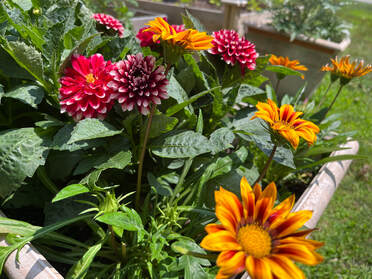 Finally, there are flowers. I keep mine in pots so that the veg has enough space to expand. This year I planted a number of different types but--thanks to the British program "Gardeners' World"--I went in big for Dahlias. They are outrageous and I may have found a new thing to take a deep-dive on this winter when everything is bleak. I bought three common varieties and inter-planted with Gazanias, which are similarly hardy. The effect is perfect for morning coffee contemplation and I usually end that time of day by deadheading those three pots. Yes I play favorites. Next year I will order some more of both and of different types. The Gazania tray I picked up promised a variety but really were just the attractive yellow ones in the picture. I never thought of myself as a flower person. They seem so impractical. This year, though, their impractical beauty has been just what I needed at the beginning of many days. So that is where I am now. I may add something more if the cucumbers finally fail and if there is an herb I would like to establish where the poor basil used to be. Carrots maybe? It feels late for them. I may just expand the greens section, which is rather cramped but produces plenty of arugula and micro-kale to make salads interesting. I did also add one yellow squash. A couple of nights ago I had--I think for the first time in my adult life--a zucchini dish that I liked and considered planting one. Sadly I couldn't find anything at the garden store, hence the compromise-squash. Many of the shops are transitioning to other things now and we are stuck with the seedlings that are left. Still, I needn't have worried about the zucchini. The neighbors have way too many and gave us a couple. We probably don't need more than one plant in the neighborhood. Again, this isn't really just a hiking blog. That is no more true than right now. A family-wide Covid epidemic has left us isolated at home and sick as dogs. Thankfully, we are vaccinated. I actually had my second booster the day my wife started showing symptoms. Though that last shot turned out to be a couple weeks too late, I am glad for the other ones. Who knows how horrid it would have been otherwise. Anyway, this hiatus from our usual weekend hiking expeditions has made me realize how important they are. The hiking part is important, sure. More important, however, is just being outdoors. Being cooped up indoors most of the time is exhausting more than any hike. It is why I don't like winter. You are either moving around skiing, snowshoeing or whatever or you are trapped at the office or the living room. It is hard to just sit. Drives me crazy. So the past few days on into the weekend I am getting familiar with my garden. The garden is pretty much my project. My eldest son--who normally grows vegetables for a living--has customarily helped, but now he is on the Appalachian Trail. Middle son--who also grows veg--has no interest in more gardening when he gets home from work. Youngest son hates gardens and vegetables. My wife is content to let it be my project. This means it usually takes a back seat to hiking and any other free-time activities. But here I am...sick. So the past few days have consisted of me planting, weeding, dividing, and harvesting...runny nose, startling hacking cough and all. Then, exhausted, I stumble into the shade with my coffee to stare at the garden while I plan my next project...once I catch my breath. My garden--two raised beds, an herb bed, and some old plastic planters--is not pretty. Even when everything is in peak season it has the look of an amateur. That said, it is important to me. It is another way to interact with nature. It is a way to touch the ground even in my imperfection. 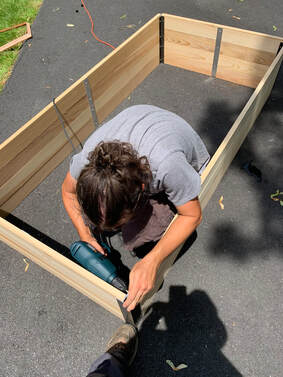 Mid-plague when we were all falling apart and I couldn't walk more than a few feet my eldest bought me a little kneeler so I could weed the herb bed, which was all we had at the time. Then he lobbied me to buy myself the first raised bed. After the surgery on my back, he helped me put it together. It is a good memory in a dark time. I still couldn't walk much or well. Now, though, I could be outside with a reason other than feeling sad. Yeah, I had "outdoor office hours" during the plague and I am outdoors typing right now. Still, it was [and is] different when you are doing inside activities outside. My neighbors probably think I am total nerd for doing this...which I am. The garden also gave us something to talk about. It wasn't that we lacked topics! Still, this one is different. It is about resurrection and growth. It is about getting better in spite of everything that holds us down. Now--while he is marching across Virginia--I text him garden questions and send him pictures a couple times a week. It is something to share other than mountain pics, which are a bit coals-to-Newcastle right now. 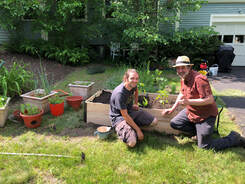 This week I divided the near-dead lavender. I hardened-off and planted some iffy pepper plants, basil, sage, fennel (for the flowers and the parasitic wasps that will make it home) rosemary and bush cukes. I made a tiny salad out of the greens that are coming up. I searched for and found a few reluctant perennials as they made their appearance, marking them off with parts of a pair of glasses I broke in my delirium. Then I wrestled with the mint. I have some spaces open for kale and eggplant and some empty flower pots still but--given my positive status--it is all over except the watering and weeding for a a couple more days. Now it is getting hot. So here are some pictures of my ugly garden. The middle ones are from past years. The first and last are from this week, taken from the relative shade of the parsonage during coffee breaks. You can see the kneeler in its "banjo seat" position. May your encounters with Creation be good ones this weekend, whatever they may be. |
Adam Tierney-EliotI am a full-time pastor in a small, progressive church in Massachusetts. This blog is about the non-church things I do to find spiritual sustenance. Archives
June 2024
Categories
All
|
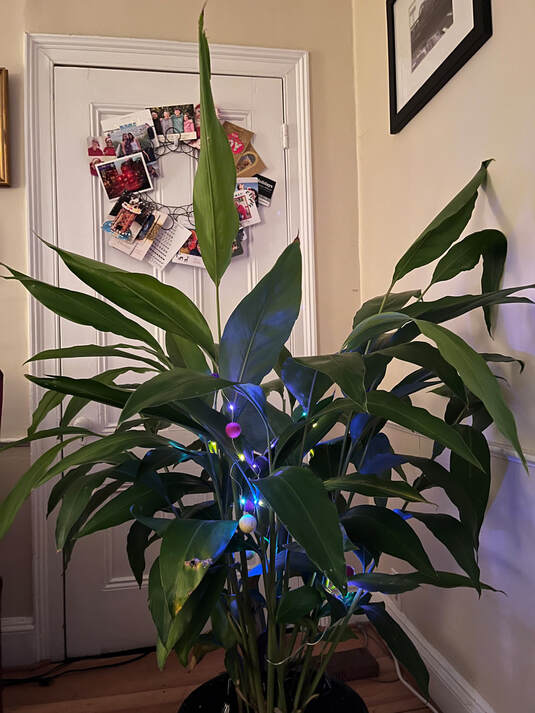
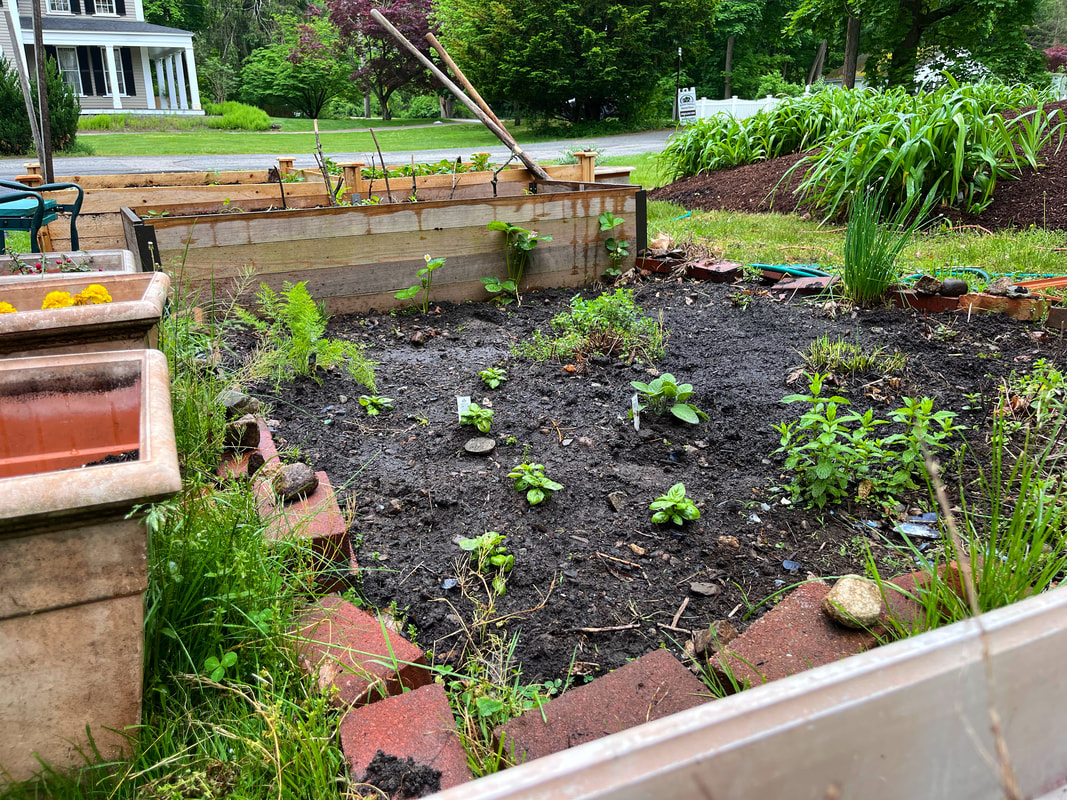
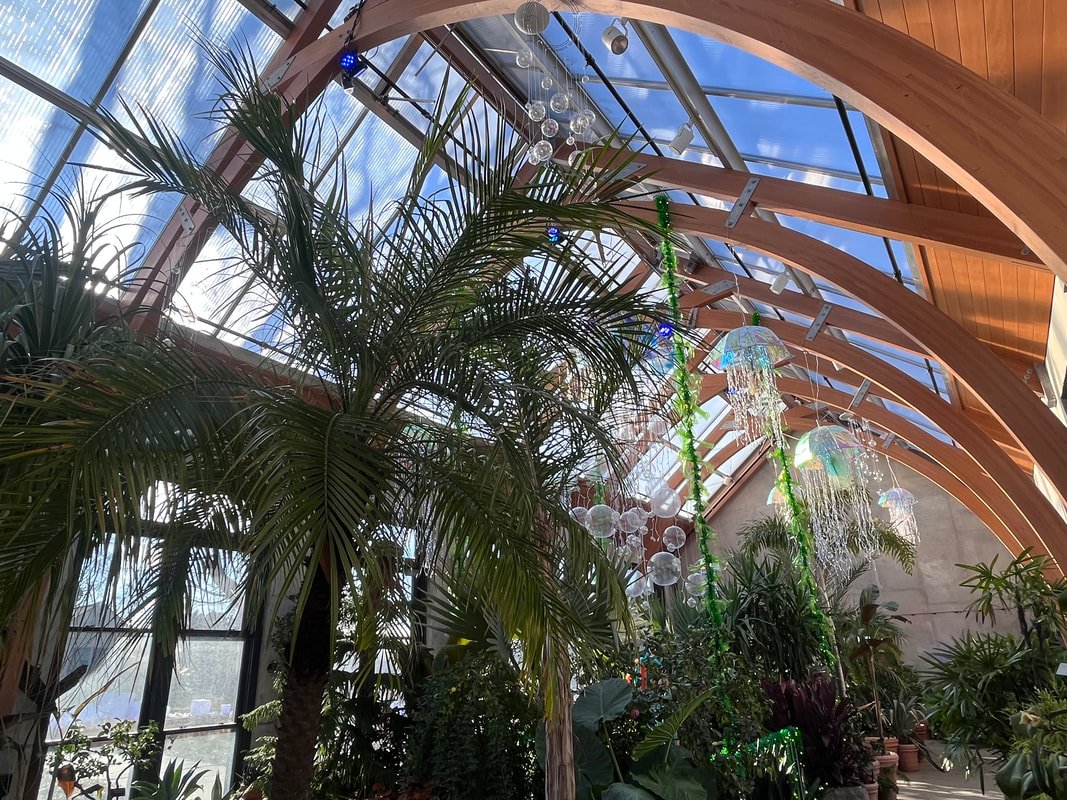
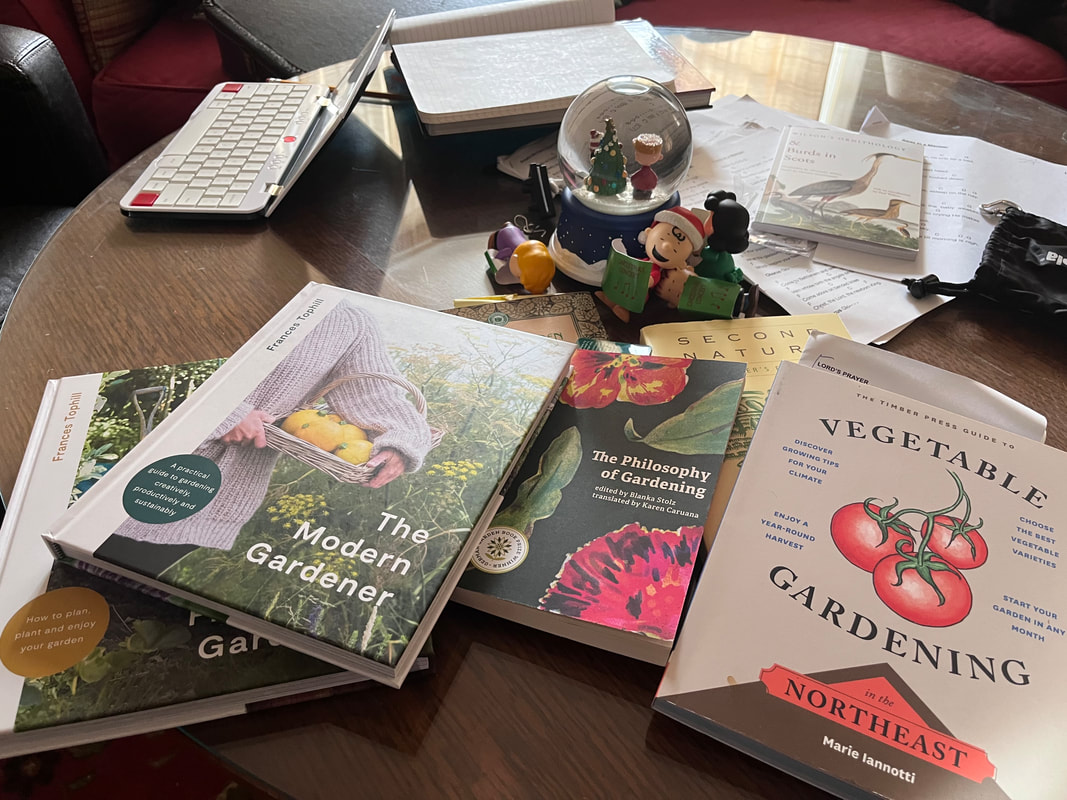
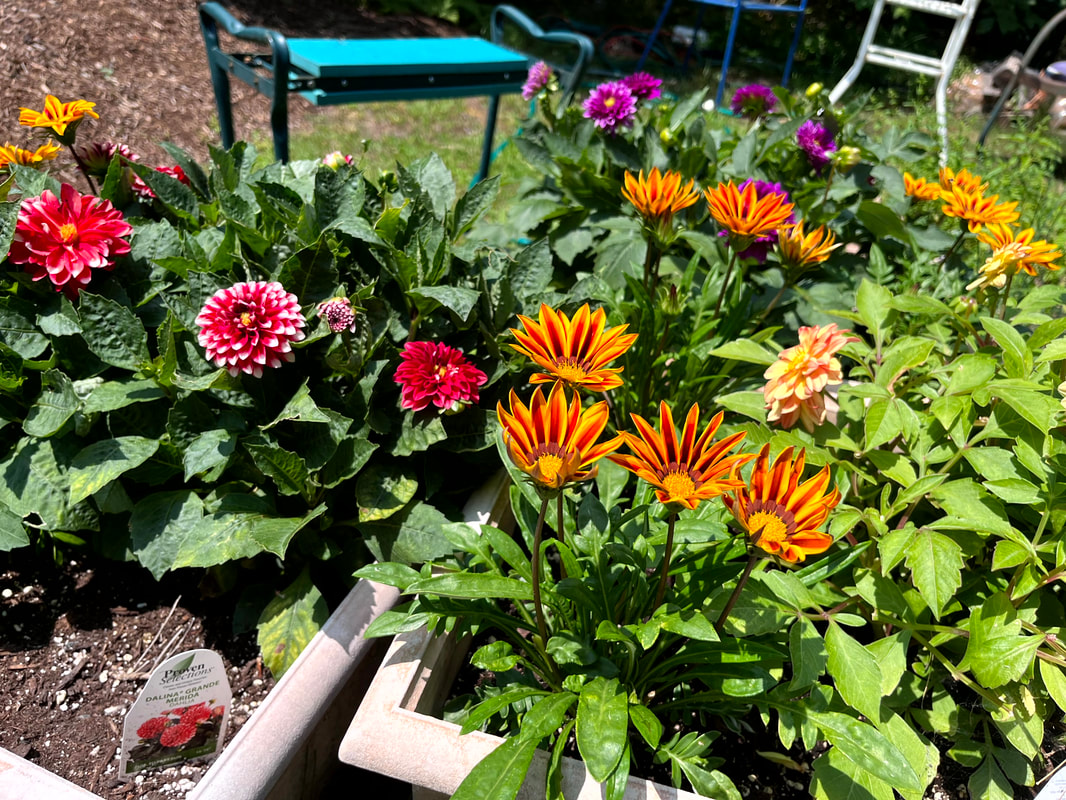
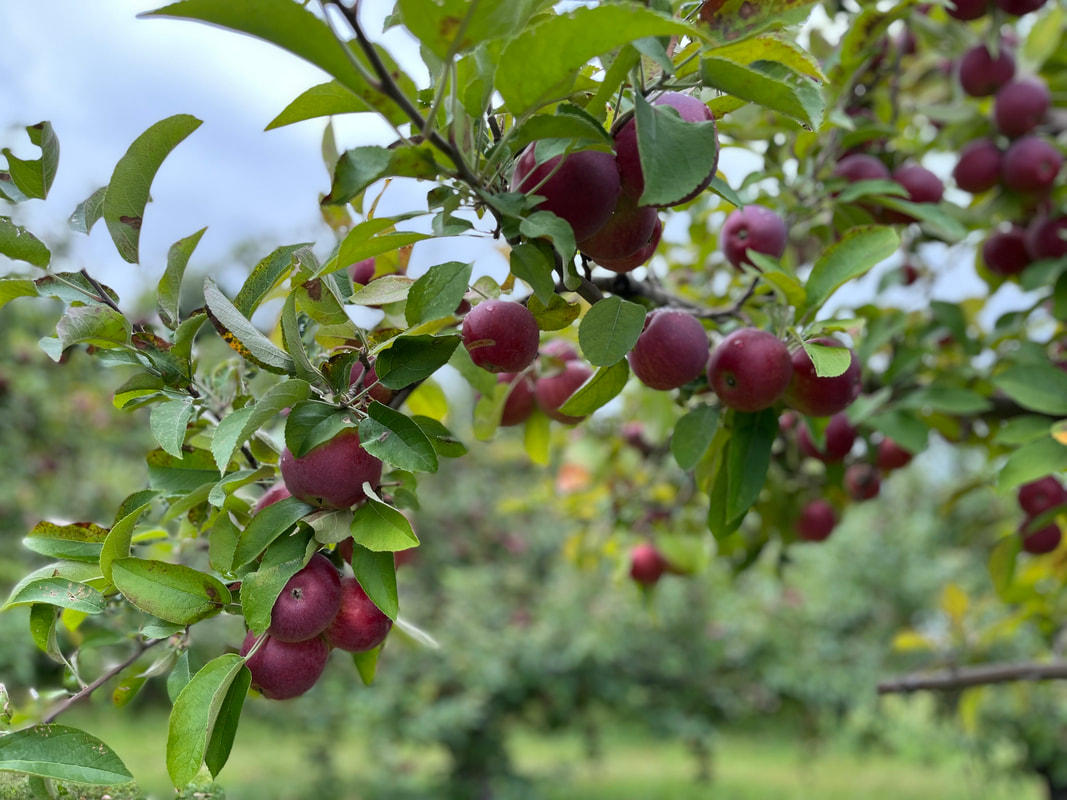
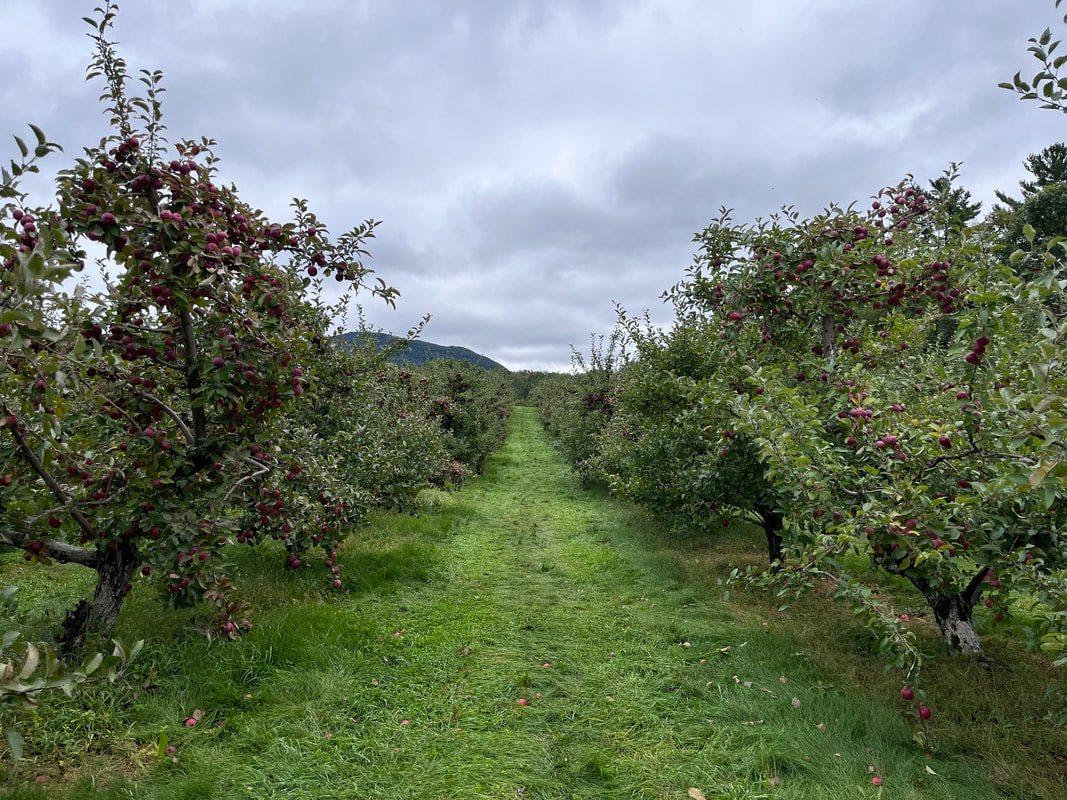
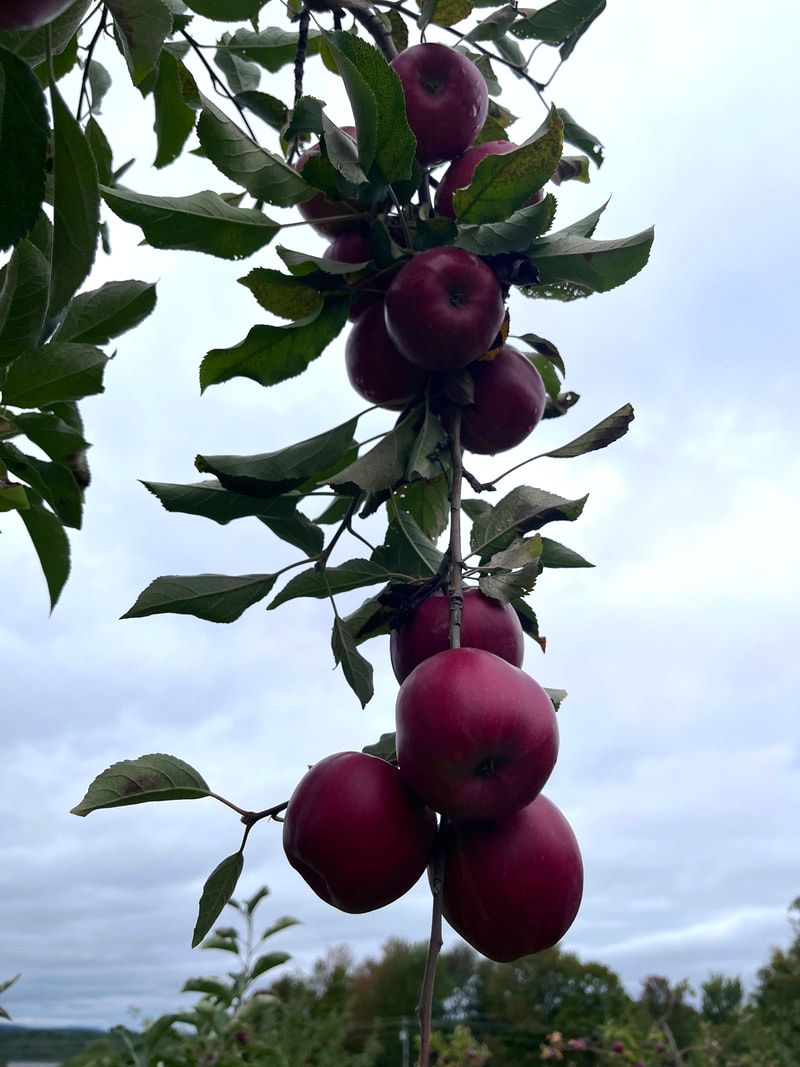
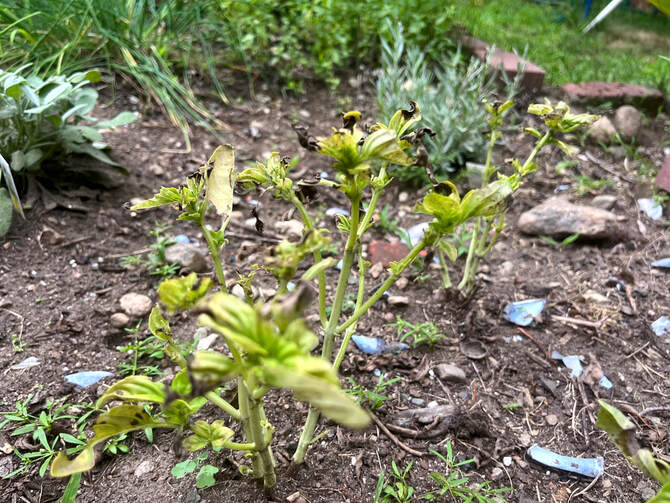
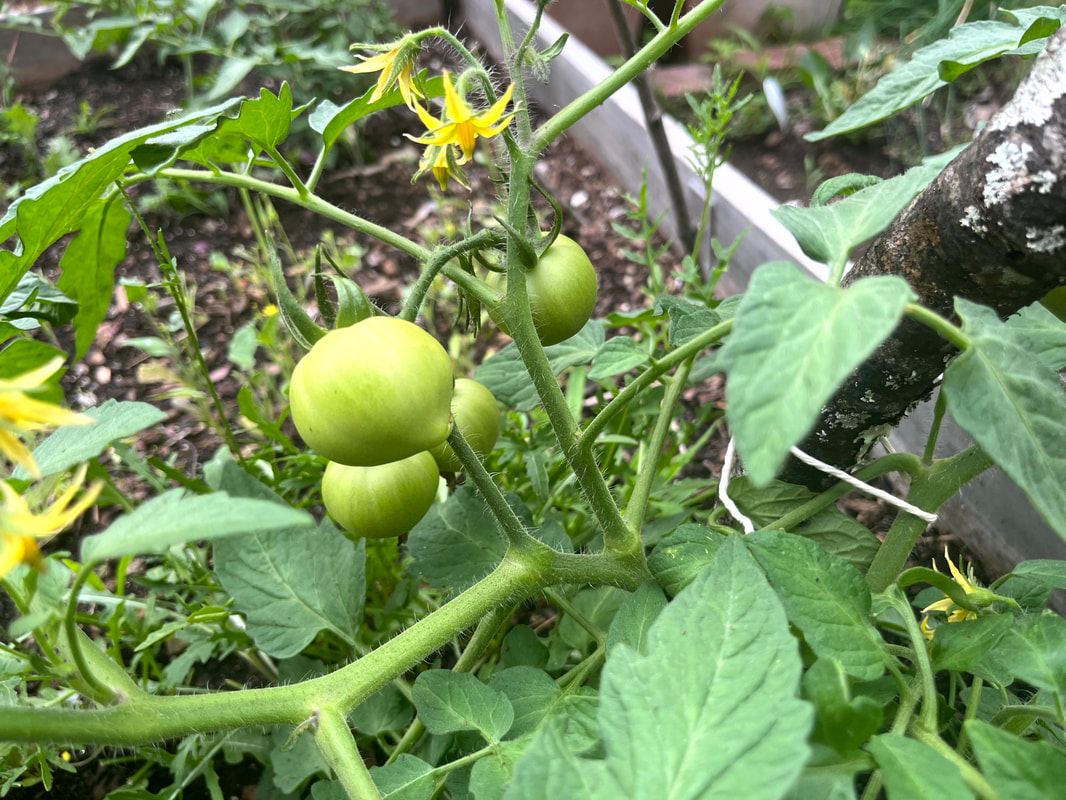
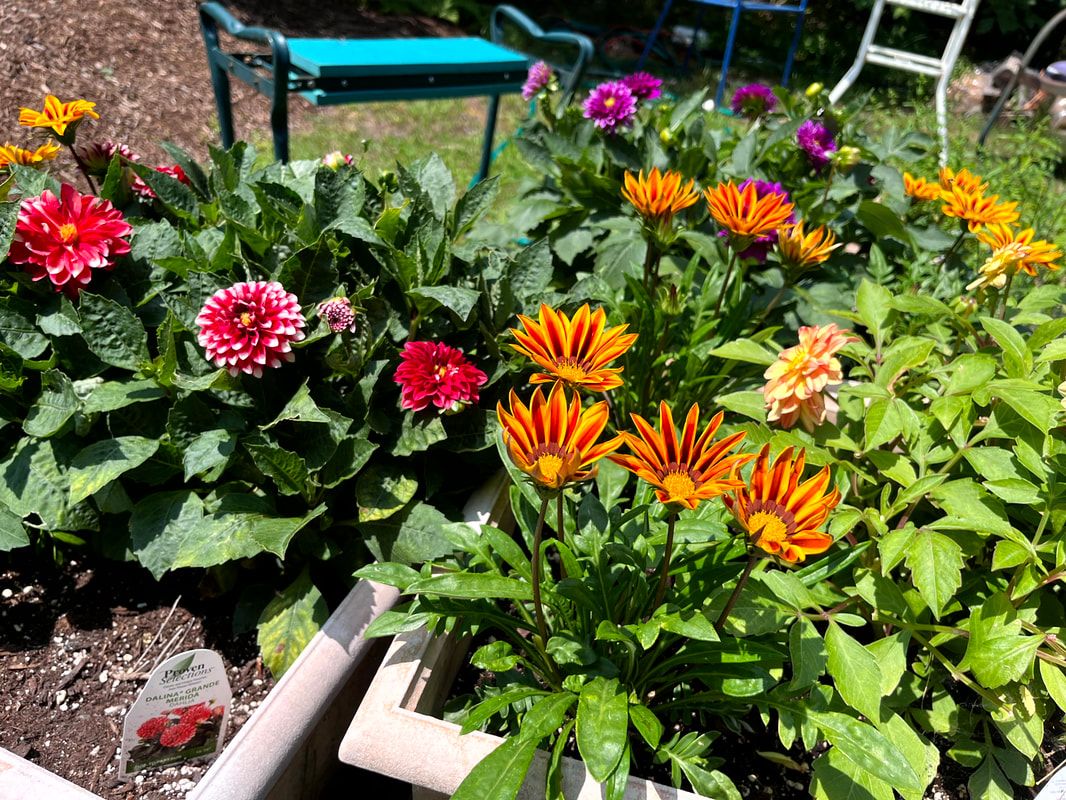
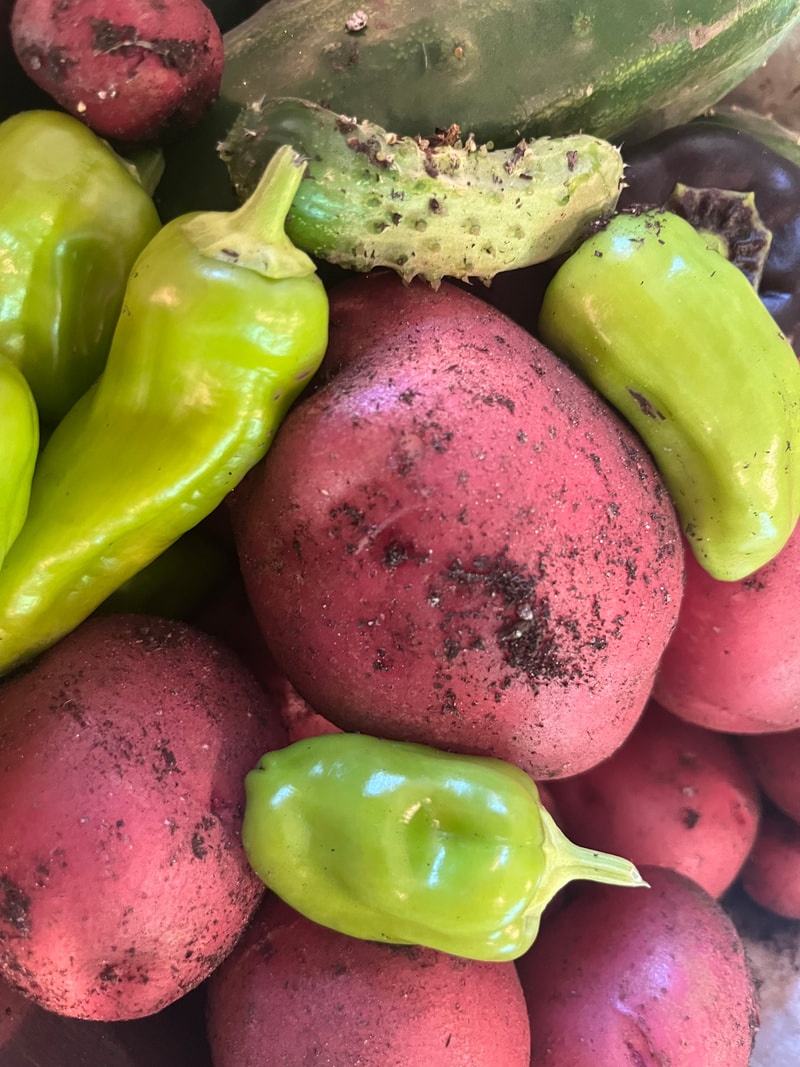
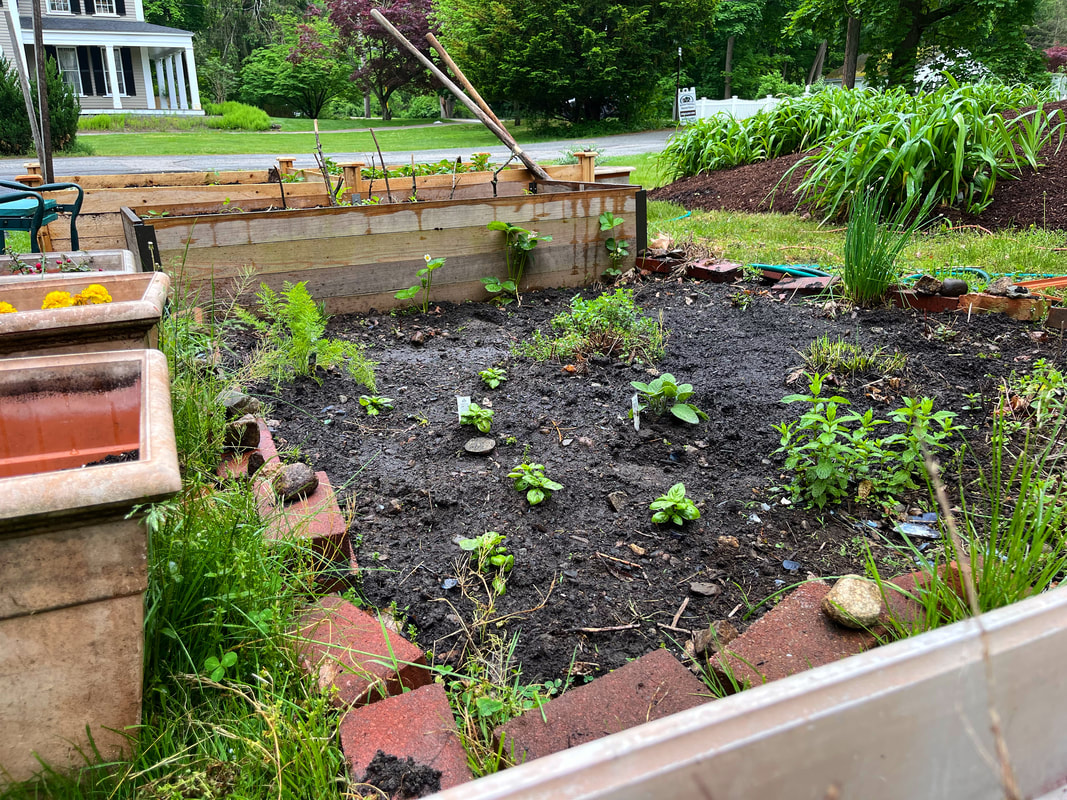
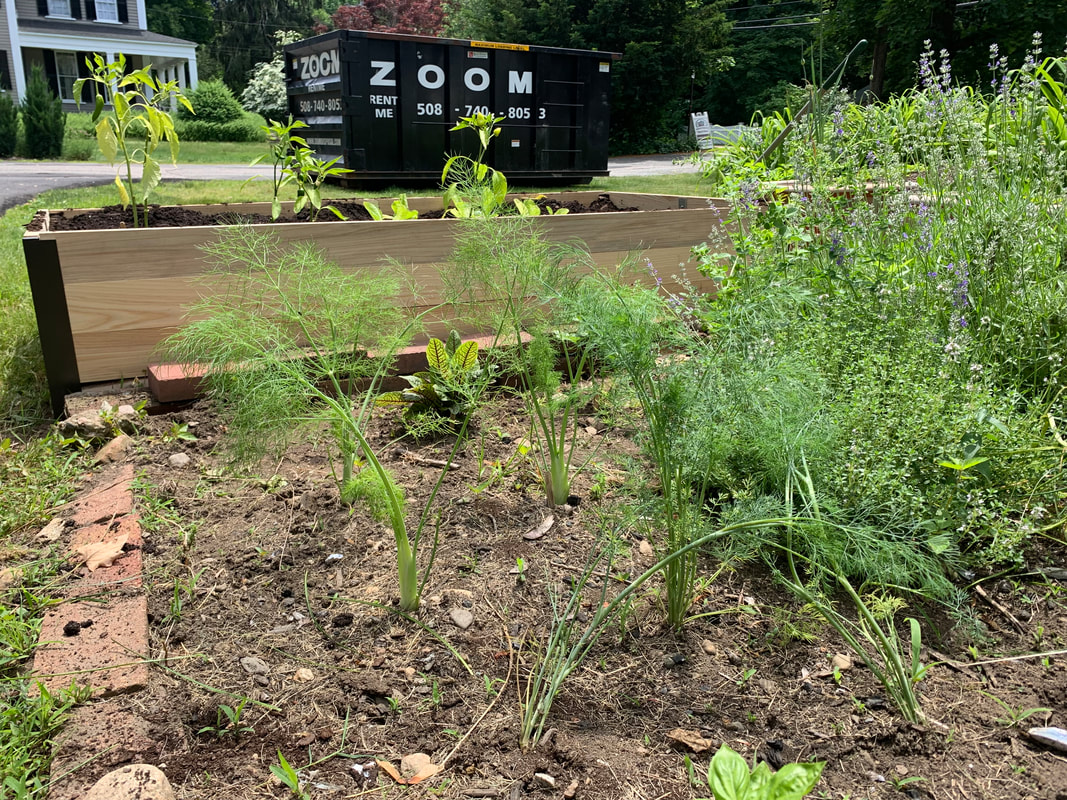
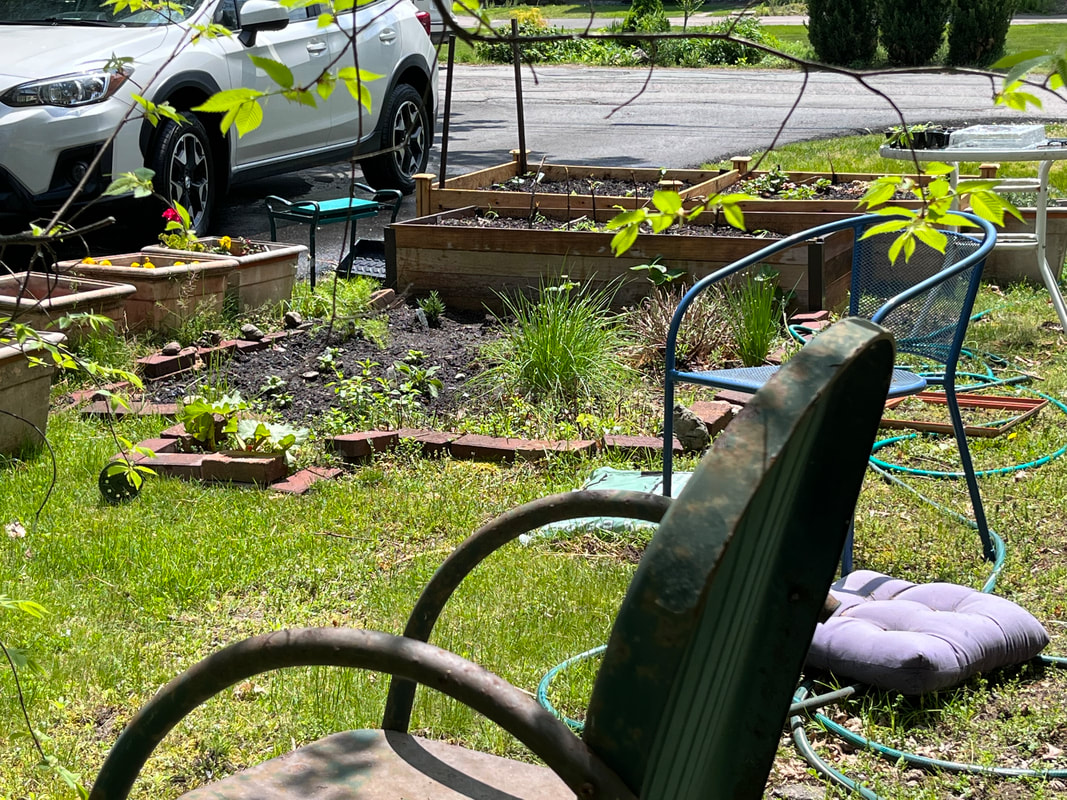
 RSS Feed
RSS Feed